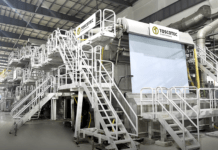Gambini has said its FlexLess Technology enables businesses to use rubber embossing rolls that do not bend when working under pressure changes, resulting in the NIP remaining even.
The FlexLess technology is easy to manufacture and assemble and there is no need to stop the machine to set up the NIP. Additionally, no adjustment is needed when the rubber wears out.
Paolo Lazzareschi, technical director of Gambini, said: “FlexLess is perfectly interchangeable with any existing machine, including non-Gambini machines, and solves a problem that Brazil has been a great concern until now.”
In October 2012, the company also launched the TouchMax embosser, which it said is “regarded as the safest and most flexible embosser in the world.”
Sales and marketing manager Carlo Berti said: “You don’t need to get into the machine or change a part of it to change the product. It is also very user- friendly: to change the product you just have to press a button on the HMI panel, it needs no other adjustments, as it is completely automatic and very intuitive. “TouchMax is targeted towards dynamic developing markets or more mature regions, where evolution is moving towards product diversification and the increase of private labels.”
He added that the unit is unique because it is “extraordinarily flexible” for fast changeover times and because it can laminate in a random or synchronised configuration with its five steel rolls always on board, two of which can emboss the lower ply while the other three can emboss the upper ply.
Gambini also offers options to reduce a company’s environmental impact and energy consumption.
Lazzareschi added: “Our machinery has high energy efficiency ratings, extremely efficient regenerative drives and high efficiency motors.
“Operationally, we try to reduce the use of motors that have to be kept running 24 hours a day, reducing consumption and getting rid of pumps.”
President Giovanni Gambini added: “The investments made in R&D over the last few years have been rewarded by the market: turnover rose by 88% from 2006 to 2012.
“Likewise, the number of complete lines and single units working every day all over the world has risen to 70 and 400 respectively.”






























